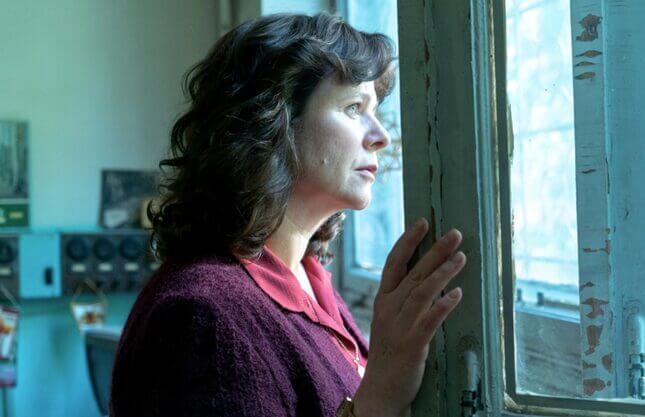The Lost Women of Chernobyl
Latest

HBO has done the unexpected and managed to turn a five-part, dead-serious miniseries about the nuclear catastrophe at Chernobyl into a cultural event, complete with memes. The show is a sober examination of the disaster and its literal fallout on the surrounding population. But turning real historical events into blockbuster TV fodder almost necessarily means flattening and cropping in the interest of storytelling, and Chernobyl is no exception.
The lead characters of Chernobyl are Jared Harris and Stellan Skarsgård, playing Valery Legasov and Boris Scherbina, the scientist and the government man, respectively, tasked with handling the disaster. While the real-life team that handled the disaster has been collapsed into these two characters, each man is modeled off a real person who lead the response. To this pair, the filmmakers also added a composite character, Emily Watson’s Ulana Khomyuk, who investigates the incident.
Along with this trio, the series focuses on the people who were closest to the events at the site—real-life plant employees, firemen, and the soldiers who did the work of containment and “liquidation,” performing ugly tasks like putting down all the household pets left behind who were hopelessly irradiated. These frantic efforts to contain the disaster at the plant overshadow the quieter storylines of the people who lived in the surrounding area. Consequently, outside of Khomyuk, there are relatively few women. The show only pulls back to investigate Lyudmilla Ignatenko, the pregnant wife of one of the horrifically unprepared firefighters who is sent to Moscow with radiation poisoning, who is based on a real person.
These frantic efforts to contain the disaster at the plant overshadow the quieter storylines of the people who lived in the surrounding area.
While Khomyuk is also based on real people, she’s the most heavily fictionalized of the leads—and the most traditionally Hollywood: a tough-minded investigator with a strong moral code, a classic movie trope. She has the benefit of adding a woman’s voice to the script, a necessity in 2019. The show’s close focus and narrative streamlining is understandable in a blockbuster TV miniseries that literally has to explain nuclear science to its audience. But the real women of Chernobyl tell just as fascinating a story as this invented amalgam.
One is a woman left out of the TV series but included in Adam Higginbotham’s Midnight in Chernobyl: Maria Protsenko, the chief architect of Pripyat, described in this excerpt from Higginbotham’s book:
A graduate in architecture from the Institute of Roads and Transport in Ust-Kamenogorsk, Protsenko had been Pripyat’s chief architect for seven years, with her own office on the second floor of the ispolkom. It was from there that she oversaw the execution of Pripyat’s new construction projects, with a profoundly un-Soviet eye for detail. Barred from Party membership by her Chinese birth, she brought an outsider’s zeal to her work. She roamed the streets with a ruler, checking on the quality of the concrete paneling in new apartment buildings. She chastised the construction workers for shoddy sidewalks: “Children will break their legs, and then how will you feel?” When persuasion wouldn’t work, she lashed them with invective. More than a few of the men were afraid of her.
Here’s a woman who painstakingly helped create a city that its residents considered an absolutely model place to live, working “frugally with small supplies of hardwood, ceramic tiles, or granite to decorate the interiors of Pripyat’s public buildings.” She then helped manage the supposedly temporary evacuation of its inhabitants, standing outside buffeted by irradiated dust giving directions to bus drivers before leaving the place to the irradiated wildlife, a silent symbol of Soviet decay.

She’s still alive, but she hasn’t been back to Pripyat since 1987, when she helped clean out a building full of sensitive documents that had been totally contaminated and had to be buried. Hers is the type of story that encapsulates the tragedy of Chernobyl, the human cost of the carelessness. Photos from the abandoned Pripyat loom large in the Western imagination, but before the disaster, it was a comparatively idyllic place to live, where people went sunning themselves on the banks of the river that ran by the plant. Protsenko spent years working to make the city the best possible place to live, only to see it destroyed.
Protsenko spent years working to make the city the best possible place to live, only to see it destroyed.
Another interesting figure: Dr. Angelina Guskova, the doctor who treated the fireman and others who arrived deathly ill from radiation sickness in Moscow. She was one of the world’s leading experts in radiation sickness, because she had treated the victims of Soviet nuclear accidents over and over again in her long career; as Higginbotham wrote, “in 1970 she completed a book that described the possible consequences of a serious accident at a civilian nuclear power plant. But when she presented the manuscript to the deputy health minister of the USSR, he threw it furiously across his office and forbade her from publishing it.” But for many of the victims from Chernobyl, there was little she could do beyond watching them die.
There are the countless others, too: those forced to pack up and leave, those who spent years worrying about the potential effects of the disaster, those who helped care for sick family members or dealt with illness themselves despite the government’s stubborn refusal to classify anybody but the most immediate victims as suffering from radiation poisoning.
That’s the thing about Chernobyl: It’s impossible to know just how many were affected. And while the HBO series is a valuable reminder that disaster has far-reaching consequences, the miniseries format means picking and choosing to create a narrative, and somebody always gets left out.